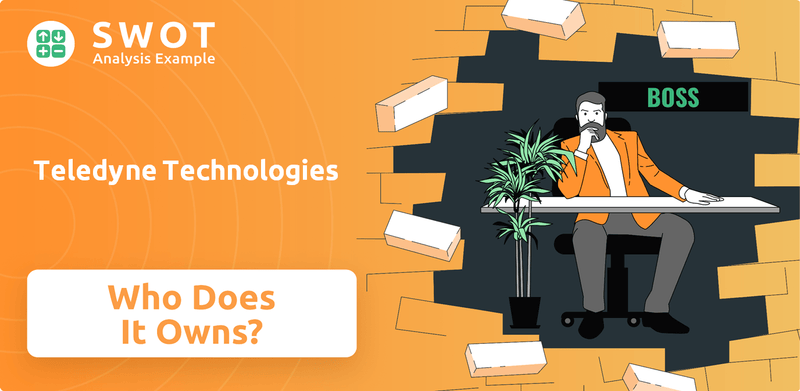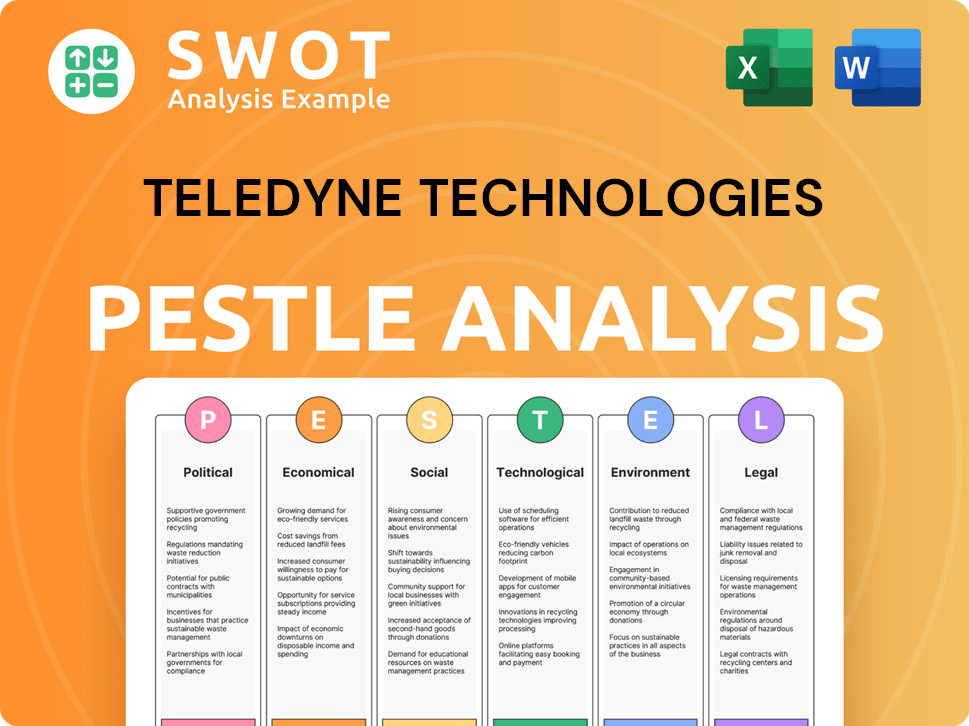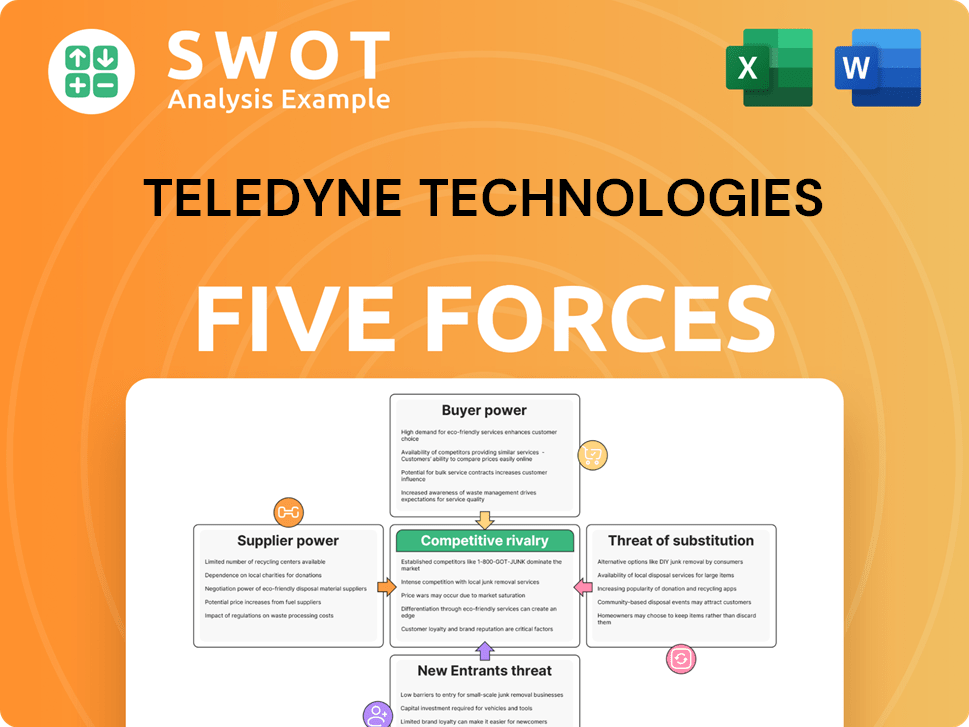Teledyne Technologies Bundle
Who Really Controls Teledyne Technologies?
Unraveling the ownership structure of a company is key to understanding its strategic direction and potential for growth. Teledyne Technologies, a leader in advanced technologies, emerged from a significant corporate spin-off, shaping its identity and trajectory. This exploration dives into the evolution of Teledyne Technologies SWOT Analysis, from its beginnings to its current standing in the market.

Understanding the dynamics of Teledyne ownership is crucial for investors and stakeholders alike. From its roots as a spin-off to its current status as a public company, the evolution of Teledyne's shareholder base provides valuable insights. This analysis will examine the influence of major investors, the role of public shareholding, and the impact of ownership changes on the company's performance, offering a comprehensive look at who owns Teledyne and how it impacts its future.
Who Founded Teledyne Technologies?
Understanding the ownership of Teledyne Technologies begins with its unique origin. Unlike companies founded by individuals, Teledyne Technologies emerged as a spin-off from Allegheny Teledyne Incorporated in 1999. This structure significantly shaped its initial ownership landscape.
The early ownership structure of Teledyne Technologies was determined by the distribution of shares to Allegheny Teledyne's shareholders. This meant that upon its inception, Teledyne Technologies became a publicly traded company, with ownership dispersed among a broad base of shareholders. This initial dispersion is a key characteristic of the company's early financial history.
The spin-off process involved agreements focused on separating assets and liabilities, establishing Teledyne Technologies as an independent entity. The focus on advanced technology businesses, as the company's core, was reflected in the assets and operations transferred during the separation. This strategic move set the stage for Teledyne Technologies' future growth and its position in the market.
The initial ownership was dispersed among shareholders of Allegheny Teledyne. This distribution formed the foundation of the company's shareholder base.
Teledyne Technologies became a publicly traded company immediately after the spin-off. This status allowed for broader investment and market participation.
Early ownership was highly fragmented, with no single individual or group holding a controlling stake. This structure influenced corporate governance.
Agreements focused on asset and liability separation were crucial. These agreements ensured a smooth transition and independent operation.
The new company's focus on advanced technology was reflected in the assets transferred. This focus shaped its strategic direction.
The spin-off established Teledyne Technologies as an independent entity. This independence allowed for focused growth.
As a publicly traded company, Teledyne Technologies' ownership structure has evolved over time. Understanding the current Teledyne ownership involves examining its major shareholders and the distribution of its stock. The company's financial performance, including its market capitalization, which was approximately $20.5 billion as of late 2024, and its stock price, are key indicators of its value and investor confidence. For more insights, consider exploring the Target Market of Teledyne Technologies to better understand its business strategy and market position. The company's annual reports provide detailed information on its financial performance and ownership structure, offering a comprehensive view of its operations.
The early ownership of Teledyne Technologies was characterized by dispersed holdings due to its spin-off from Allegheny Teledyne.
- Initial ownership was distributed among Allegheny Teledyne shareholders.
- The company became publicly traded immediately after the spin-off.
- No single entity held a controlling stake in the early stages.
- Agreements focused on separating assets and liabilities.
- The company's focus on technology was reflected in its assets.
Teledyne Technologies SWOT Analysis
- Complete SWOT Breakdown
- Fully Customizable
- Editable in Excel & Word
- Professional Formatting
- Investor-Ready Format

How Has Teledyne Technologies’s Ownership Changed Over Time?
The ownership structure of Teledyne Technologies has evolved significantly since its spin-off and initial public offering (IPO) in 1999. Initially, the market capitalization reflected the valuation of assets transferred from Allegheny Teledyne. Over time, Teledyne ownership has transitioned primarily to institutional investors, mutual funds, and index funds, which now control the majority of outstanding shares. This shift is typical for publicly traded companies and reflects broader market trends.
The acquisition of FLIR Systems in 2021 for approximately $8 billion was a pivotal event. This acquisition not only impacted Teledyne's valuation but also attracted further institutional investment. This strategic move solidified Teledyne's position in various markets, influencing its financial performance and attracting significant investor interest. The Teledyne Technologies company profile has been enhanced through such strategic acquisitions.
| Shareholder | Approximate Percentage of Shares (as of December 31, 2024) | Notes |
|---|---|---|
| The Vanguard Group | Over 11% | A major institutional investor. |
| BlackRock | Approximately 9% | Another significant institutional shareholder. |
| State Street Global Advisors | Significant | Holds shares on behalf of clients. |
Individual insider ownership, including executives and board members, represents a smaller but still significant portion. These insiders align their interests with the long-term performance of the company. Major institutional shareholders influence Teledyne's strategy and governance through their voting power and engagement with management. Understanding the Teledyne shareholders is crucial for anyone looking into Teledyne stock.
Teledyne Technologies' ownership is largely institutional, with significant holdings by major asset management firms. This structure reflects a mature public company with diverse investors. For more insights, see the Marketing Strategy of Teledyne Technologies.
- Institutional investors hold the majority of shares.
- Insider ownership ensures alignment with company performance.
- Strategic acquisitions have shaped the ownership landscape.
- Understanding the Teledyne ownership structure is crucial for investors.
Teledyne Technologies PESTLE Analysis
- Covers All 6 PESTLE Categories
- No Research Needed – Save Hours of Work
- Built by Experts, Trusted by Consultants
- Instant Download, Ready to Use
- 100% Editable, Fully Customizable

Who Sits on Teledyne Technologies’s Board?
The current Board of Directors of Teledyne Technologies plays a vital role in the company's governance, representing shareholder interests. The board typically includes a mix of independent directors and those with executive roles within the company. For example, Robert Mehrabian serves as the Executive Chairman, while Edwin R. Lewis is President and Chief Executive Officer and a director. Other board members generally have diverse expertise from various industries.
As of early 2025, the board's composition reflects a commitment to both experience and independence, which is crucial for effective oversight. The board's responsibilities include setting strategic direction, overseeing financial performance, and ensuring compliance with legal and ethical standards. The structure of the board and its committees are designed to promote transparency and accountability to all Teledyne shareholders.
| Director | Position | Details |
|---|---|---|
| Robert Mehrabian | Executive Chairman | Oversees the board and provides strategic guidance. |
| Edwin R. Lewis | President and CEO, Director | Leads the company's operations and strategic initiatives. |
| Other Independent Directors | Various | Bring diverse expertise from various industries. |
The voting structure for Teledyne Technologies is based on a one-share-one-vote principle, which is common for publicly traded companies. This means each share of common stock entitles its holder to one vote on matters brought before shareholders, such as the election of directors or approval of corporate actions. There are no indications of dual-class shares or special voting rights that would grant outsized control to specific individuals or entities. Major institutional shareholders, like Vanguard and BlackRock, hold significant portions of the stock, and their influence is primarily through their substantial voting blocks, which they can exercise in line with their investment policies. For more details, you can check out the Brief History of Teledyne Technologies.
Teledyne ownership structure ensures that voting power is proportional to share ownership, which is a standard practice in the U.S. market. This structure allows all shareholders to have a voice in the company's direction. Major institutional investors such as Vanguard and BlackRock hold significant shares, which gives them considerable influence through their voting power.
- One-share-one-vote principle.
- Significant institutional ownership.
- Transparency in voting processes.
- Shareholder influence through voting.
Teledyne Technologies Business Model Canvas
- Complete 9-Block Business Model Canvas
- Effortlessly Communicate Your Business Strategy
- Investor-Ready BMC Format
- 100% Editable and Customizable
- Clear and Structured Layout

What Recent Changes Have Shaped Teledyne Technologies’s Ownership Landscape?
Over the past few years, Teledyne Technologies has seen significant developments impacting its ownership. The acquisition of FLIR Systems in 2021, valued at approximately $8 billion, was a pivotal move. This strategic acquisition likely reshaped the shareholder base, attracting investors interested in the company's expanded technological scope and market reach. This expansion is a key element of understanding the evolution of Teledyne ownership.
The company has also actively engaged in share buyback programs. These programs are designed to reduce the number of outstanding shares, potentially increasing earnings per share and consolidating ownership among existing shareholders. As of December 2024, Teledyne's net common stock repurchases exceeded $118 million, reflecting a commitment to enhancing shareholder value. These actions help determine who owns Teledyne and how the ownership structure is evolving.
Industry trends, particularly the growing influence of institutional investors, are evident in Teledyne's ownership structure. Large asset managers continue to hold substantial stakes, contributing to a more dispersed, yet professionally managed, ownership base. The focus remains on strategic growth, both through acquisitions and internal development, indicating a commitment to long-term value creation. The company's preference for stable, long-term strategic investors underscores its dedication to sustained growth in its specialized technology markets. This focus is crucial for investors looking at Teledyne Technologies and its future.
The ownership of Teledyne Technologies is primarily composed of institutional investors. These include major asset management firms that hold significant portions of the company's stock. The structure reflects a trend towards professionally managed ownership.
Teledyne has been active in share buyback programs, which reduce the number of outstanding shares. This action can increase the earnings per share, benefiting existing shareholders. As of December 2024, over $118 million was spent on repurchases.
The acquisition of FLIR Systems in 2021 was a major strategic move. It expanded the company's technological capabilities and market reach. This acquisition likely attracted new institutional investors.
The company emphasizes the importance of long-term strategic investors. This preference supports sustained growth in its specialized technology markets. The focus is on enhancing shareholder value over time.
Teledyne Technologies Porter's Five Forces Analysis
- Covers All 5 Competitive Forces in Detail
- Structured for Consultants, Students, and Founders
- 100% Editable in Microsoft Word & Excel
- Instant Digital Download – Use Immediately
- Compatible with Mac & PC – Fully Unlocked

Related Blogs
- What are Mission Vision & Core Values of Teledyne Technologies Company?
- What is Competitive Landscape of Teledyne Technologies Company?
- What is Growth Strategy and Future Prospects of Teledyne Technologies Company?
- How Does Teledyne Technologies Company Work?
- What is Sales and Marketing Strategy of Teledyne Technologies Company?
- What is Brief History of Teledyne Technologies Company?
- What is Customer Demographics and Target Market of Teledyne Technologies Company?
Disclaimer
All information, articles, and product details provided on this website are for general informational and educational purposes only. We do not claim any ownership over, nor do we intend to infringe upon, any trademarks, copyrights, logos, brand names, or other intellectual property mentioned or depicted on this site. Such intellectual property remains the property of its respective owners, and any references here are made solely for identification or informational purposes, without implying any affiliation, endorsement, or partnership.
We make no representations or warranties, express or implied, regarding the accuracy, completeness, or suitability of any content or products presented. Nothing on this website should be construed as legal, tax, investment, financial, medical, or other professional advice. In addition, no part of this site—including articles or product references—constitutes a solicitation, recommendation, endorsement, advertisement, or offer to buy or sell any securities, franchises, or other financial instruments, particularly in jurisdictions where such activity would be unlawful.
All content is of a general nature and may not address the specific circumstances of any individual or entity. It is not a substitute for professional advice or services. Any actions you take based on the information provided here are strictly at your own risk. You accept full responsibility for any decisions or outcomes arising from your use of this website and agree to release us from any liability in connection with your use of, or reliance upon, the content or products found herein.